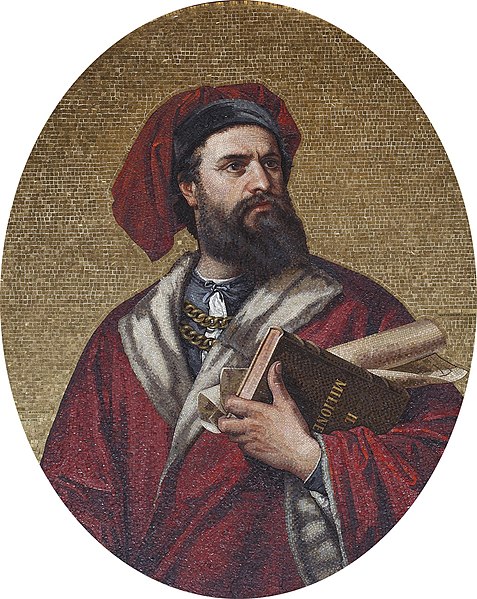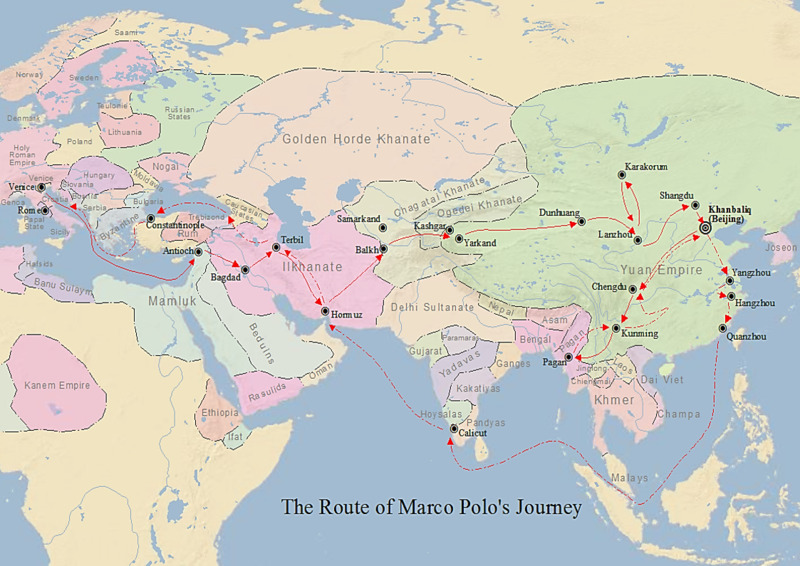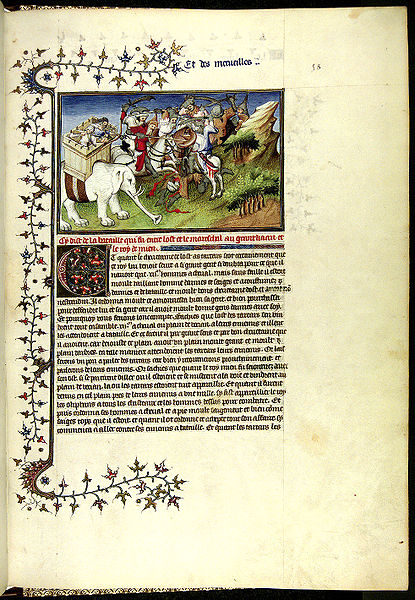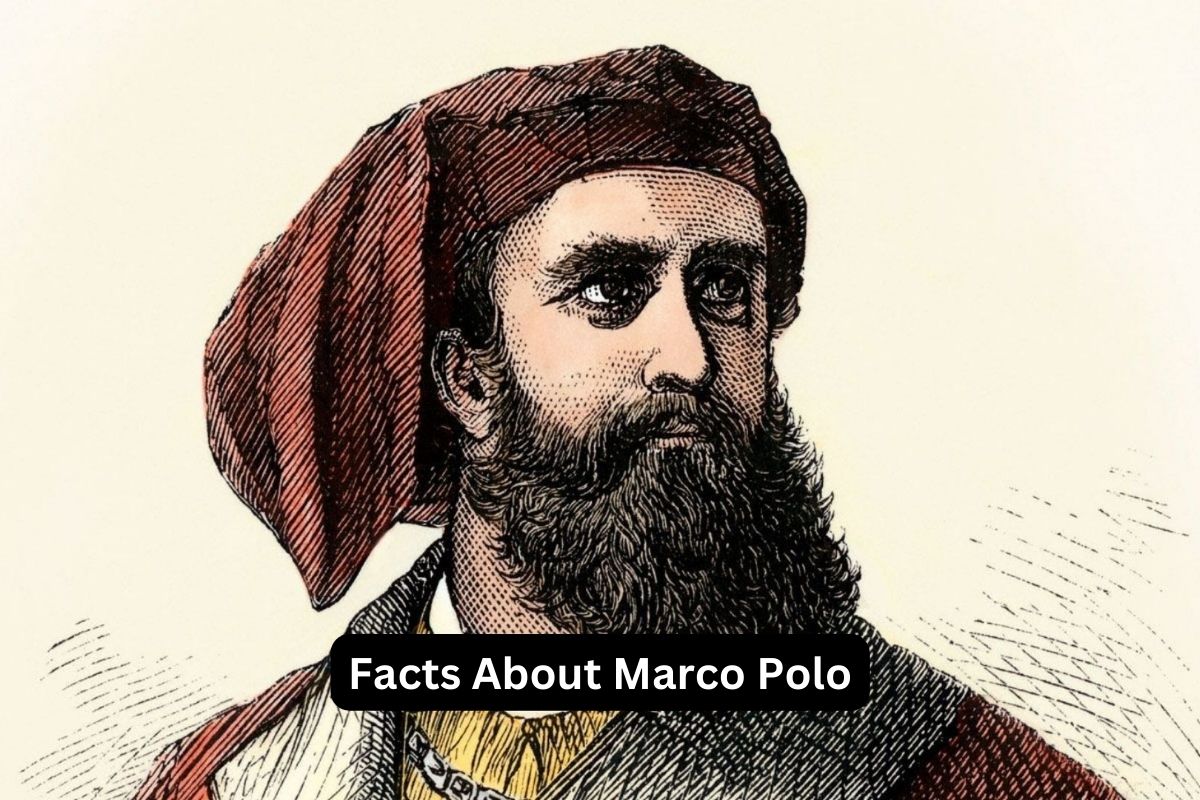Marco Polo (1254-1324) was an Italian explorer and merchant from Venice. He embarked on a journey to Asia at the age of 17, reaching the court of Kublai Khan in China. He spent 17 years traveling throughout China and other parts of Asia.
Upon his return to Venice, he was involved in maritime warfare and captured during a naval battle with Genoa. While imprisoned, he shared his travel experiences, which led to the creation of his book, “The Travels of Marco Polo.”
Published in 1298, the book became a success, inspiring future explorers and shaping European perceptions of Asia. Marco Polo’s legacy as an explorer and his contributions to bridging East and West are renowned.
Marco Polo Facts
1. Marco Polo was an Italian explorer and merchant
Marco Polo was an Italian explorer and merchant born in Venice, Italy, in 1254. Venice was a thriving maritime republic and a hub of trade during the Middle Ages. Growing up in this bustling city, Marco Polo was exposed to the world of commerce and exploration from an early age.

2. He was born in 1254 in Venice, Italy, into a wealthy merchant family
Marco Polo came from a family of merchants. His father, Niccolò Polo, and uncle, Maffeo Polo, were successful traders who had established business connections in the eastern Mediterranean and the Black Sea region.
Also Read: Marco Polo Accomplishments
In 1260, when Marco was just six years old, his father and uncle embarked on a journey to Asia for trade purposes. They traveled along the Silk Road, a network of trade routes connecting Europe with the East, and eventually reached the court of Kublai Khan in China.
3. At the age of 17, Marco Polo embarked on a journey to Asia with his father and uncle
At the age of 17, Marco Polo accompanied his father and uncle on their second journey to Asia. The trio set out on their voyage in 1271 and traveled through the Middle East, Central Asia, and across the treacherous Taklamakan Desert.
They encountered various cultures, landscapes, and challenges along the way, but their determination led them to reach the court of Kublai Khan in 1275.
It is important to note that the exact details of Marco Polo’s early life and his first journey to Asia are not extensively documented. Much of what is known comes from his own writings and the accounts of others. Nevertheless, these early experiences laid the foundation for Marco Polo’s later adventures and his notable exploration of China.
4. Marco Polo spent 17 years in the service of Kublai Khan and traveled extensively throughout China
Marco Polo spent approximately 17 years in the service of Kublai Khan, the ruler of the Mongol Empire and the founder of the Yuan Dynasty in China. During this time, Marco Polo held various administrative positions and was trusted with important missions by the emperor.
His fluency in multiple languages and his understanding of Asian customs and cultures made him a valuable asset to Kublai Khan.

5. During his travels, Marco Polo explored many regions of China
Throughout his extensive travels in China, Marco Polo explored numerous regions and cities. He visited the imperial capital of Beijing (known as Khanbaliq during that time) and marveled at its grandeur and the Khan’s opulent palace.
He also traveled to other prominent cities such as Hangzhou, which was a major trading hub and renowned for its prosperity and beauty. Marco Polo was particularly impressed by the city’s extensive network of canals, its bustling markets, and its advanced agricultural techniques.
6. Marco Polo was fascinated by the culture, customs, and technological advancements he encountered in China
Marco Polo was deeply fascinated by the culture, customs, and technological advancements he encountered in China. He was particularly intrigued by the paper money system used by the Chinese, which was quite different from the coin-based economies of Europe.
Marco Polo also witnessed the use of coal as a source of fuel, something unfamiliar to Europeans at the time. Additionally, he described Chinese inventions such as gunpowder and the compass, which were instrumental in shaping world history.
7. “The Travels of Marco Polo” introduced Europeans to the concept of paper money, coal, and various Chinese inventions
“The Travels of Marco Polo” is a seminal work that documented Marco Polo’s experiences and adventures in Asia. The book, also known as “Il Milione” or “The Book of the Marvels of the World,” was written while Marco Polo was imprisoned in Genoa in the early 1290s.
He dictated his stories to his fellow prisoner, Rustichello da Pisa, who helped write and compile the book. It was first published in 1298 and quickly gained popularity throughout Europe.

8. The book also sparked interest in Asia and played a significant role in the European Age of Discovery
The publication of “The Travels of Marco Polo” sparked a newfound interest in Asia among Europeans and played a significant role in the European Age of Discovery. Polo’s vivid descriptions of the vast wealth and splendor of the Mongol Empire, the exotic lands he encountered, and the remarkable achievements of the East captivated the imaginations of readers across Europe.
9. Upon returning to Venice in 1295, Marco Polo became involved in maritime warfare and was captured during a naval battle between Venice and Genoa
After spending approximately 17 years in the service of Kublai Khan in China, Marco Polo finally returned to his hometown of Venice in 1295. However, his arrival coincided with a turbulent period in Venetian history, marked by ongoing conflicts with rival maritime republics, most notably Genoa.
Upon his return, Marco Polo found himself caught up in the intense maritime warfare between Venice and Genoa. In 1298, he actively participated in a naval battle near the coast of Curzola (modern-day Korčula, Croatia). This clash, known as the Battle of Curzola or the Battle of Meloria, was part of the ongoing struggle for dominance over Mediterranean trade routes.
During the battle, Polo fought valiantly for the Venetian fleet. However, the Venetians suffered a significant defeat, and Polo was among the many captured by the Genoese forces. As a prisoner of war, Polo found himself confined in a Genoese prison.
10. “The Travels of Marco Polo” was published in 1298 and became an instant success
“The Travels of Marco Polo” was published in 1298, and its release quickly garnered widespread attention and acclaim. The book became an instant success, capturing the imagination of readers throughout Europe. Its popularity can be attributed to several factors.
Firstly, at the time of its publication, Europe was experiencing a surge of interest in travel literature and exploration narratives. Marco Polo’s accounts of his adventures in faraway lands, filled with exotic customs, rich cultures, and tales of vast wealth, catered to this growing curiosity.
People were eager to learn about the world beyond their immediate surroundings, and Polo’s book provided them with an exciting glimpse into the mysterious and fabled East.
Secondly, Polo’s book arrived at a time when the political and economic climate in Europe was conducive to receiving such accounts. The Mongol Empire, under the rule of Kublai Khan, held a position of significant power and influence.
Trade between Europe and the East was flourishing along the Silk Road, and there was a rising interest in establishing direct access to the wealth and resources of Asia. Polo’s firsthand descriptions of the vast markets, opulent cities, and prosperous economies of the East struck a chord with European merchants and adventurers who saw immense potential in these distant lands.
11. Marco Polo’s accounts of his travels were met with skepticism by some, as they seemed too extraordinary to be true
While “The Travels of Marco Polo” garnered widespread acclaim, it also faced skepticism from some scholars and readers who found his tales too extraordinary to be true. Polo’s descriptions of the cities, customs, and wealth seemed almost mythical to many Europeans.
However, subsequent explorers and archaeologists have confirmed many of his accounts, validating the accuracy of his observations and experiences.
12. Marco Polo’s book described the vast wealth and splendor of the Mongol Empire, which fueled European desires to establish trade routes to Asia
The book played a crucial role in shaping European perceptions of Asia and fueled the desire for further exploration and trade. It contributed to the European Age of Discovery, inspiring future explorers, including Christopher Columbus, who carried a copy of “The Travels of Marco Polo” during his voyages.
Polo’s descriptions of the wealth and exoticism of the East motivated European powers to seek direct sea routes to Asia, leading to significant maritime expeditions and the establishment of global trading networks.
13. Marco Polo’s legacy is celebrated today, and he is regarded as one of the most significant explorers in history
Marco Polo’s legacy as one of history’s greatest explorers endures to this day. His travels helped bridge the gap between East and West, paving the way for increased trade, diplomatic relations, and cultural exchange.
His book remains an important historical document that sheds light on the medieval world, and Marco Polo himself is celebrated for his adventurous spirit, curiosity, and his role in expanding European understanding of the world beyond their borders.
